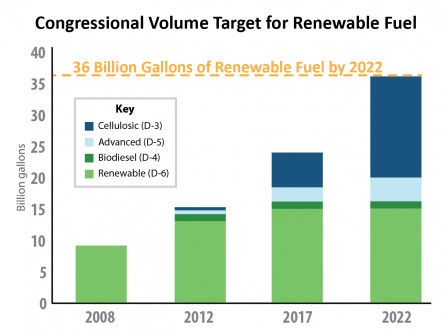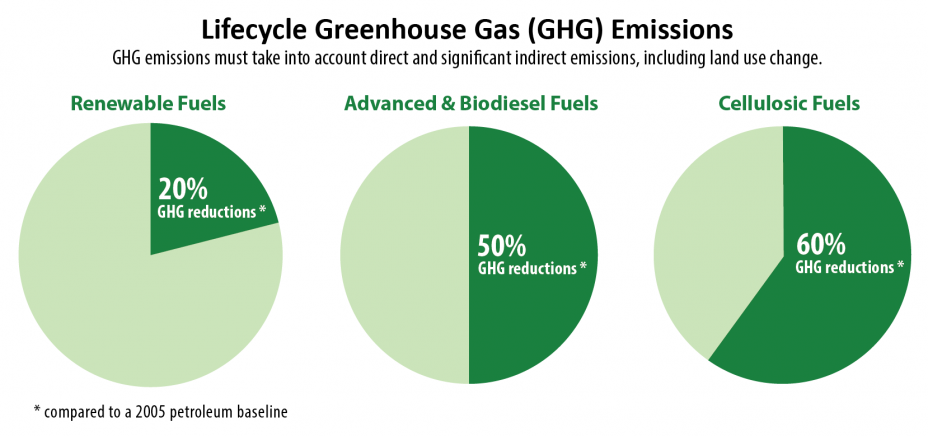Overview for Renewable Fuel Standard
On this page:
Program Structure
The Renewable Fuel Standard (RFS) program was created under the Energy Policy Act of 2005 (EPAct), which amended the Clean Air Act (CAA). The Energy Independence and Security Act of 2007 (EISA) further amended the CAA by expanding the RFS program. EPA implements the program in consultation with U.S. Department of Agriculture and the Department of Energy.
The RFS program is a national policy that requires a certain volume of renewable fuel to replace or reduce the quantity of petroleum-based transportation fuel, heating oil or jet fuel. The four renewable fuel categories under the RFS are:
- Biomass-based diesel
- Cellulosic biofuel
- Advanced biofuel
- Total renewable fuel
The 2007 enactment of EISA significantly increased the size of the program and included key changes, including:
- Boosting the long-term goals to 36 billion gallons of renewable fuel
- Extending yearly volume requirements out to 2022
- Adding explicit definitions for renewable fuels to qualify (e.g., renewable biomass, GHG emissions)
- Creating grandfathering allowances for volumes from certain existing facilities
- Including specific types of waiver authorities
Volumes provided in the statute are in the following table:
Volume Standards as Set Forth in EISA |
|||||
|---|---|---|---|---|---|
| Year | Cellulosic Biofuel | Biomass-Based Diesel | Advanced Biofuel | Total Renewable Fuel | "Conventional" Biofuel |
| 2009 | NA | 0.5 | 0.6 | 11.1 | 10.5 |
| 2010 | 0.1 | 0.65 | 0.95 | 12.95 | 12.0 |
| 2011 | 0.25 | 0.8 | 1.35 | 13.95 | 12.6 |
| 2012 | 0.5 | 1.0 | 2.0 | 15.2 | 13.2 |
| 2013 | 1.0 | * | 2.75 | 16.55 | 13.8 |
| 2014 | 1.75 | * | 3.75 | 18.15 | 14.4 |
| 2015 | 3.0 | * | 5.5 | 20.5 | 15.0 |
| 2016 | 4.25 | * | 7.25 | 22.25 | 15.0 |
| 2017 | 5.5 | * | 9.0 | 24.0 | 15.0 |
| 2018 | 7.0 | * | 11.0 | 26.0 | 15.0 |
| 2019 | 8.5 | * | 13.0 | 28.0 | 15.0 |
| 2020 | 10.5 | * | 15.0 | 30.0 | 15.0 |
| 2021 | 13.5 | * | 18.0 | 33.0 | 15.0 |
| 2022 | 16.0 | * | 21.0 | 36.0 | 15.0 |
|
*statute sets 1 billion gallons minimum, but EPA may raise requirement Note: There is no statutory volume requirement for "conventional" biofuel. The conventional volumes in the table are calculated (total - advanced) and are certain biofuels that do not qualify as advanced. |
|||||
The Clean Air Act provides EPA authority to adjust cellulosic, advanced and total volumes set by Congress as part of the annual rule process.
The statute also contains a general waiver authority that allows the Administrator to waive the RFS volumes, in whole or in part, based on a determination that implementation of the program is causing severe economic or environmental harm, or based on inadequate domestic supply.
 Click the image for a larger version.
Click the image for a larger version.
Fuel Pathways
For a fuel to qualify as a renewable fuel under the RFS program, EPA must determine that the fuel qualifies under the statute and regulations. Among other requirements, fuels must achieve a reduction in greenhouse gas (GHG) emissions as compared to a 2005 petroleum baseline.
EPA has approved fuel pathways under the RFS program under all four categories of renewable fuel. Advanced pathways already approved include ethanol made from sugarcane; jet fuel made from camelina; cellulosic ethanol made from corn stover; compressed natural gas from municipal wastewater treatment facility digesters; and others.
- Biomass-based diesel must meet a 50% lifecycle GHG reduction
- Cellulosic biofuel must be produced from cellulose, hemicellulose, or lignin and must meet a 60% lifecycle GHG reduction
- Advanced biofuel can be produced from qualifying renewable biomass (except corn starch) and must meet a 50% GHG reduction
- Renewable (or conventional) fuel typically refers to ethanol derived from corn starch and must meet a 20% lifecycle GHG reduction threshold
Lifecycle GHG reduction comparisons are based on a 2005 petroleum baseline as mandated by EISA. Biofuel facilities (domestic and foreign) that were producing fuel prior to enactment of EISA in 2007 are “grandfathered” under the statute, meaning these facilities are not required to meet the GHG reductions.
EPA continues to review and approve new pathways, including for fuels made with advanced technologies or with new feedstocks. Certain biofuels are similar enough to gasoline or diesel that they do not have to be blended, but can be simply “dropped in” to existing petroleum-based fuels. These drop-in biofuels directly replace petroleum-based fuels and hold particular promise for the future.
 Click the image for a larger version.
Click the image for a larger version.
Learn more about fuel pathway under the RFS program.
Program Compliance Basics
Obligated parties under the RFS program are refiners or importers of gasoline or diesel fuel. Compliance is achieved by blending renewable fuels into transportation fuel, or by obtaining credits (called “Renewable Identification Numbers”, or RINs) to meet an EPA-specified Renewable Volume Obligation (RVO).
EPA calculates and establishes RVOs every year through rulemaking, based on the CAA volume requirements and projections of gasoline and diesel production for the coming year. The standards are converted into a percentage and obligated parties must demonstrate compliance annually.
Each fuel type is assigned a “D-code” – a code that identifies the renewable fuel type – based on the feedstock used, fuel type produced, energy inputs and GHG reduction thresholds, among other requirements. The four categories of renewable fuel have the following assigned D-codes:
- Cellulosic biofuel is assigned a D-code of 3 (e.g., cellulosic biofuel) or D-code of 7 (cellulosic diesel)
- Biomass-based diesel is assigned a D-code of 4
- Advanced biofuel is assigned a D-code of 5
- Renewable fuel (non-advanced/conventional biofuel) is assigned a D-code of 6 (grandfathered fuels are also assigned a D-code of 6)
“Renewable identification numbers” or RINs are the credits that obligated parties use to demonstrate compliance with the standard. Obligated parties must obtain sufficient RINs for each category in order to demonstrate compliance with the annual standard.
More information on RINs:
- RINs are generated when a producer makes a gallon of renewable fuel
- At the end of the compliance year, obligated parties use RINs to demonstrate compliance
- RINs can be traded between parties
- Obligated parties can buy gallons of renewable fuel with RINs attached. They can also buy RINs on the market
- Obligated parties can carry over unused RINs between compliance years. They may carry a compliance deficit into the next year. This deficit must be made up the following year.
The RFS program’s four renewable fuel standards are nested within each other. In other words, the fuel with a higher GHG reduction threshold can be used to meet the standards for a lower GHG reduction threshold. For example, fuels or RINs for advanced biofuel (i.e., cellulosic, biodiesel or sugarcane ethanol) can be used to meet the total renewable fuel standards (i.e., corn ethanol).
The table below shows which RIN type and D-code can be used to demonstrate compliance with the four categories of fuel that together comprise an obligated parties’ renewable volume obligation (RVO):
| D-Code | Cellulosic Biofuel | Biomass-Based Diesel | Advanced Biofuel | Total Renewable Fuel |
|---|---|---|---|---|
| 3 | X | X | X | |
| 4 | X | X | X | |
| 5 | X | X | ||
| 6 | X | |||
| 7 | X | X | X |
For cellulosic standards, an additional flexibility is provided. Cellulosic waiver credits (CWC) are offered by EPA at a price determined by formula in the statute. Obligated parties have the option of purchasing CWCs plus an advanced RIN in lieu of blending cellulosic biofuel or obtaining a cellulosic RIN.
Learn more about RFS program compliance at Fuels Registration, Reporting and Compliance Help.
